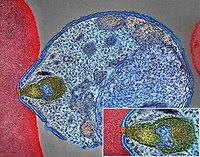
Photo from wikipedia
BACKGROUND Insecticide resistance management has been key for crop protection for over 70 years and is increasingly important because the development of new active ingredients has decreased in recent years. By… Click to show full abstract
BACKGROUND Insecticide resistance management has been key for crop protection for over 70 years and is increasingly important because the development of new active ingredients has decreased in recent years. By monitoring the development of resistance in a timely manner, we can effectively prolong insecticide efficacy. Genomic-based diagnosis can reliably predict resistance development if information on resistant mutations against major pesticides is available. Here, we developed a feasibility trial of genomics-based diagnosis of insecticide resistance in diamondback moth (Plutella xylostella) populations in Nagano Prefecture, Japan. Amplicon sequencing analyses using a next-generation sequencer (Illumina MiSeq) for major insecticides, including diamides, pyrethroids, Bacillus thuringiensis (Bt) toxin (Cry1Ac), organophosphates, and spinosyns, were conducted. RESULTS Mutations related to the resistance of pyrethroids, organophosphates, and diamides (flubendiamide and chlorantraniliprole) prevailed, while those of a diamide (cyantraniliprole), Bt (Cry1Ac), and spinosyns were scanty, suggesting that they are still effective. The results of the genomics-based diagnosis were generally concordant with the results of bioassays. Resistance development tendencies were generally uniform across Nagano. CONCLUSION Insecticide-resistance management campaign can be conducted in Nagano Prefecture with a quick genomic-based diagnosis in early spring while bioassay is the only option for monitoring resistances whose mutations are unavailable. Our study is the first step in the future management of insecticide resistance in all significant pests.
Journal Title: Pest management science
Year Published: 2022
Link to full text (if available)
Share on Social Media: Sign Up to like & get
recommendations!